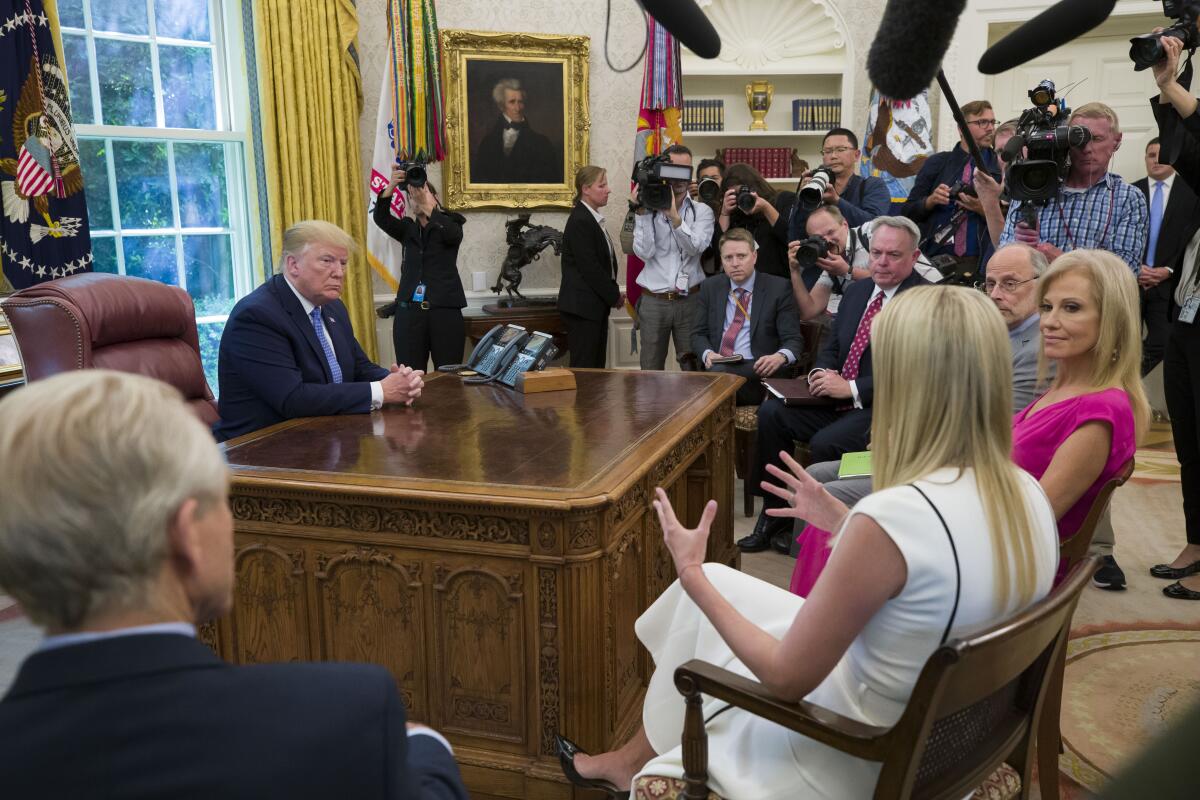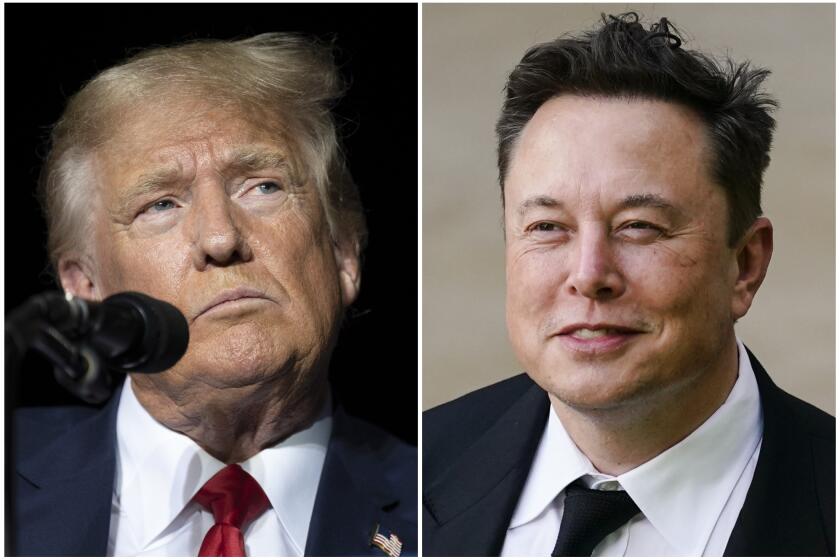Before coronavirus failures, Trump struggled to slow drug overdoses

- Share via
WASHINGTON — It was cast as a signature initiative for President Trump’s new administration — bold action to combat an epidemic of drug addiction, which claimed some 64,000 lives the year Trump was elected, many in the small towns and rural areas key to his victory.
“Watch what happens, if we do our jobs, how the number of drug users and the addicted will start to tumble downward over a period of years. It will be a beautiful thing to see,” the president said at a White House ceremony in October 2017, when he announced a public health emergency to take on the crisis.
Yet, even as the White House kept rolling out media events, the death toll has continued to mount. Fatal overdoses in 2019 were up more than 10% from 2016, federal data show.
And across the country, public health officials, researchers and physicians say that despite some progress expanding drug treatment, the administration has largely failed to mobilize the kind of broad, national effort needed to save more lives.
“Unfortunately, the uptick in deaths shows we still haven’t broadly implemented things that we know work,” said Dr. Sarah Wakeman, medical director of the substance use disorder initiative at Massachusetts General Hospital in Boston. “Until we do, we’re going to continue to see deaths.”
Instead, in a pattern with echoes in Trump’s response to the COVID-19 outbreak, the White House has often favored rosy talk over real results.
Another parallel to the coronavirus response: The administration’s consistent opposition to expanding the nation’s healthcare safety net has impeded efforts to get more Americans into drug treatment, healthcare experts said.
Chuck Ingoglia, who heads the National Council for Behavioral Health, whose members include leading mental health and addiction treatment providers, said he couldn’t think of any Trump administration initiatives that have made a substantial difference in the crisis.
And Dr. Shawn Ryan, a leader of the American Society of Addiction Medicine who runs a network of addiction clinics around Cincinnati, said the president’s main accomplishment may simply be signing legislation developed by Congress two years ago to provide additional money for addiction treatment.
“I can’t point to anything they’ve done that’s transformational,” Ryan said.
Trump administration officials defended their response, noting that billions of dollars of federal aid to states have helped expand drug treatment and slow addictions to pain medications and heroin.
“I have never seen the level of resources put into any substance-use issue, and certainly not opioids,” said Dr. Elinore McCance-Katz, a psychiatrist whom Trump tapped in 2017 to head the Substance Abuse and Mental Health Services Administration.
But Ryan and others working on the front lines to reduce substance use say the crisis has only worsened this year, as the federal government’s failure to control the coronavirus — even as other wealthy nations have — is driving up drug use and putting treatment further out of reach for many sick Americans.
“We see a huge storm coming this fall,” said Kody Kinsley, who oversees substance use and behavioral health programs at the North Carolina Health and Human Services Department.
As people lose jobs and health insurance, growing numbers are unable to get care for addiction, Kinsley noted. “There is virtually no safety net to catch these folks.”
North Carolina is among a dozen states where Republican opposition to expanding Medicaid eligibility through the Affordable Care Act has left many poor adults without access to insurance.
In other states at the center of the opioid epidemic, expanding Medicaid to cover low-income working adults has been a vital tool, state health officials say. In Ohio, for example, more than a third of approximately 700,000 people who enrolled in Medicaid after expansion reported some drug- or alcohol-dependence.
Nevertheless, the Trump administration has been working for 3 ½ years to roll back the 2010 healthcare law and the Medicaid expansion it authorized. The administration is currently supporting a lawsuit by Texas and other GOP-led states to repeal the whole law that, if successful, would strip health insurance from tens of millions of Americans.
“Insurance coverage is the chassis on which treatment is built,” said Brendan Saloner, an expert on substance use policy at the Johns Hopkins Bloomberg School of Public Health. “Yet this is an administration that’s shown no real commitment to preserving coverage.”
The federal government in recent years has increased aid to states to combat the opioid crisis, funded by bills passed by Congress, first in 2016 under President Obama, and then in 2018 under Trump.
The Trump administration loosened some rules to make it easier for substance-use patients to get treatment using telehealth and to fill prescriptions for addiction medicine.
And a nationwide effort to better track and limit prescriptions for opioid-based pain medicine has helped lower prescribing rates, a trend that began in 2012.
The increased funding helped increase access to treatment and to life-saving medicine, data show. But the improvements in many cases just continued trends already underway before Trump took office.
Retail prescriptions for nalaxone, the life-saving antidote used to revive drug overdose victims, doubled between 2017 and 2018, for example, according to data analyzed by the federal Centers for Disease Control and Prevention.
That was the same rate of increase as between 2016 and 2017, and slower than the increase between 2015 and 2016.
Similarly, in the first two years of the Trump administration, use of buprenorphine, a medicine widely recommended for treating patients with opioid addictions, increased at the same rate as in the years before Trump was elected, researchers found.
More worrisome, the researchers found that buprenorphine use has been declining among younger Americans, a trend that also began before Trump.
“It may be tempting to try to paint a rosy picture, but it’s definitely not rosy,” said Dr. Mark Olfson, a Columbia University epidemiologist who led the study on buprenorphine. “While the trend line is up, and that is encouraging, most people still aren’t getting the treatment they need.”
And while the additional federal aid has helped, state leaders said the administration’s preference for grants that last a year or two, rather than a permanent financing system such as Medicaid, has made it more difficult to build lasting systems to treat people suffering from addition.
“It can feel like you get some money, you distribute it, you do some novel things with clinics, and then, poof, it’s gone,” said Dr. Jeffrey Schiff, the former chief medical officer at Minnesota’s Medicaid program, who spent years working on substance use treatment in the state. “You’re not going to turn the money away, but it doesn’t support a sustained strategy.”
More broadly, public health officials noted that the Trump administration’s efforts to pare back the broader safety net, including cutting housing assistance, unemployment and food aid, threatens the supports that people suffering from addiction vitally need.
That has left the country trying to control an epidemic without really addressing many of the root causes of addiction, said Dr. Karen Smith, who served as California’s public health director from 2015 to 2019.
“Our national strategy is like buying a new tire every time you hit a pothole, instead of investing in fixing the road,” Smith said. “For the amount of money we’re spending, the results we’re getting are pretty pathetic.”
More to Read
Get the L.A. Times Politics newsletter
Deeply reported insights into legislation, politics and policy from Sacramento, Washington and beyond. In your inbox twice per week.
You may occasionally receive promotional content from the Los Angeles Times.











